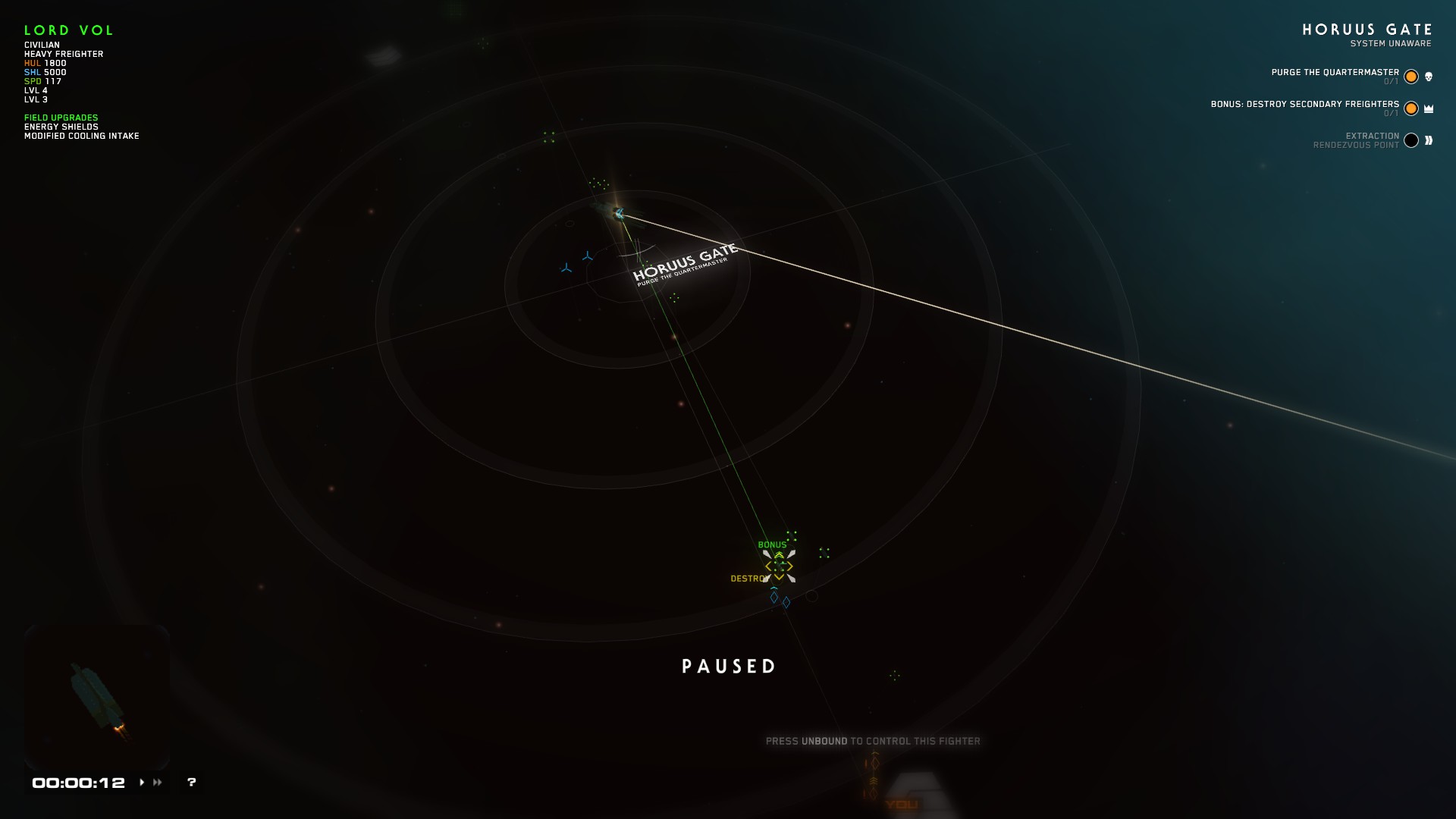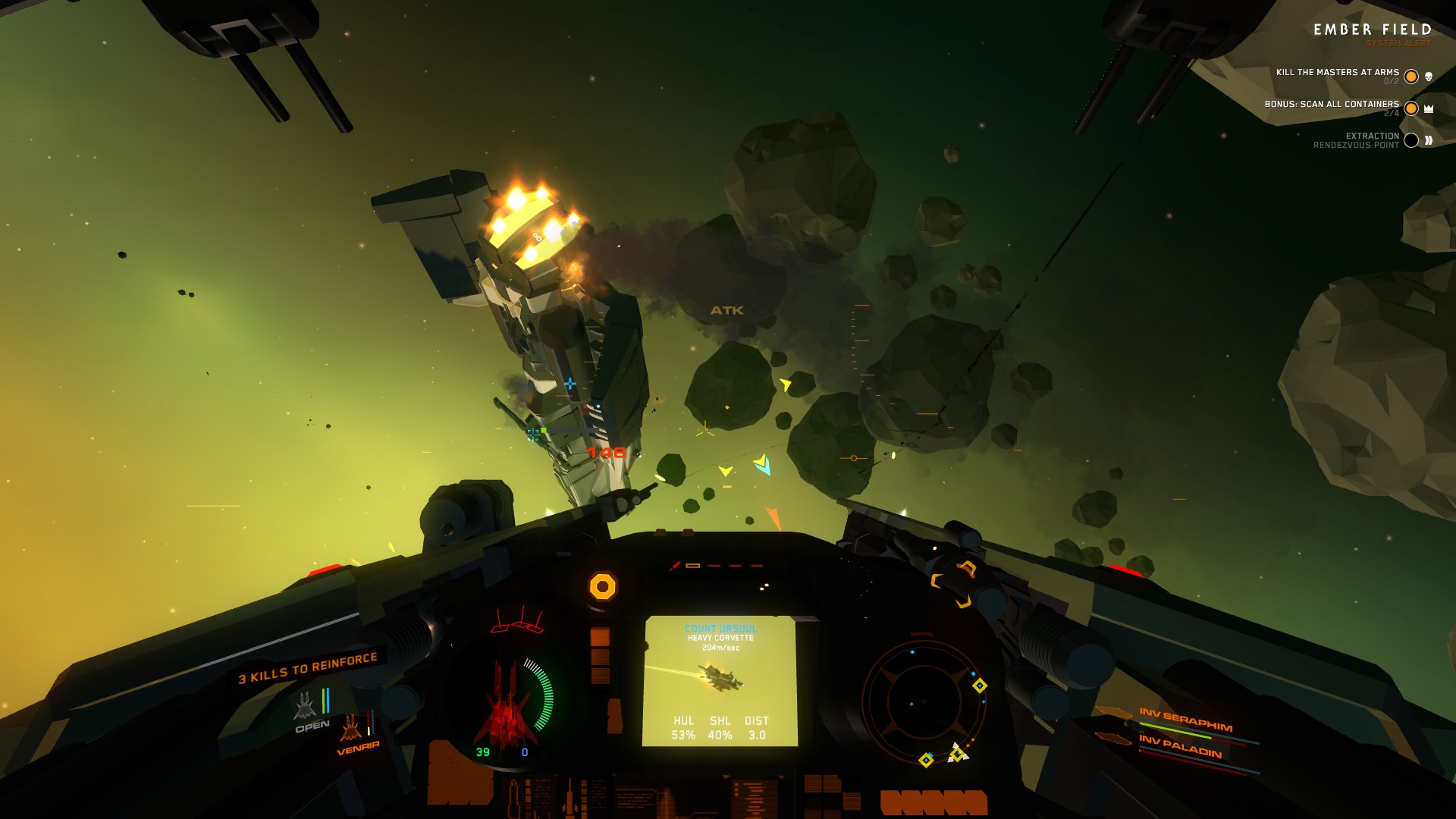House of the Dying Sun is the stylish child of Homeworld and Battlestar
A space shooter that drops the simulation in favor of challenging, intense action.
House of the Dying Sun doesn't span the stars like Freespace or Wing Commander—there are no elaborate briefings, long patrols through multiple waypoints, or intercom chit-chat with friends and enemies —but man, is it sexy. Brightly-colored ships slash through rust-red clouds of ancient dust, leaving thin lines of exhaust in their wake, while martial drums beat in the background, behind the crackling voices of cold, hard men who have grown comfortable with killing. It looks like Homeworld, it sounds like Battlestar, and it is gloriously, unrepentantly brutal.
Enemies who eject from their ships are not to be captured: They die. Ships filled with civilian workers in the employ of your enemies? They die. Examples must be made. You might call them war crimes; to the remnants of the Royal Guard, the near-fanatical military unit now under my command, they're bonus objectives.
House of the Dying Sun actually plays a little like an FPS. The WASD keys control acceleration, braking and rolls, while the mouse points your Executor fighter where you want it to go. Weapons can be gimballed, so they'll pivot to follow your cursor, meaning you don't have to line up your ship for a perfect shot to nail your enemy: Just get close, get the cursor on him, and drop the hammer. That may be anathema to purists (although I'm honestly not sure what's hot/socially acceptable in space jockey society these days), but it fits House of the Dying Sun brilliantly because, again, it's all about presentation. Battles are fast and ferocious, and even if you're more Freecell than Freespace you can still jump in and kick ass like Buck Rogers without having to first graduate from the Imperial Flight Academy.
It's intense—almost too intense at times, because there's so much going on that it becomes incredibly difficult to keep track of it all, much less deal with it from the seat of a single fighter. And you've got to move quickly, because once you're engaged and the enemy forces are alerted, reinforcements will show up very quickly. Your fighter is the best in the fleet, but it's no match for a Traitor Lord flagship, and once one of them has arrived you've generally got just a few seconds to wrap things up and haul ass before you're turned into dust. Most missions are just a few minutes long—one way or the other.
Even if you're more Freecell than Freespace you can still jump in and kick ass like Buck Rogers.
Effectively managing wingmen becomes essential in the later missions and at higher difficulties, but while the Homeworld-style tactical pop-up is helpful, I found that it wasn't quite as functional as it could be. It provides a useful overview of the battle but no effective way of issuing orders: I could use it to get an idea of what was happening around me, but to tell my wingmen what to do I’d have to return to the cockpit view and bring up an entirely separate menu.
On the upside, it's possible to take direct control of any ship in the fleet at any time, which opens up more advanced tactics, like sending a wingman to intercept a distant or fleeing target, then taking direct control of him once he's close. It also makes the “Kamikaze Chassis” upgrade—an “impact gel” below a fighter’s armor that ignites when the hull crumples, causing a tremendous amount of damage—a more practical option, as long as you don't mind knowingly sending pilots to their deaths. (And if you do, this probably isn't the game for you.)

Mission objectives are usually just a matter of killing someone(s), but taking care of bonus objectives is vital, because doing so earns “favor” that can be spent on upgrades to shields, hull, engines, and other ship systems. Completing primary missions earns nothing but a pass to the next job—it's the bare minimum you can do in service to your Emperor, after all, and there ain't no participation medals in this gig—so if you want a better ship (and trust me, you do), you're going to have to be hot on the stick. Missions follow a linear structure, each one taking you a step closer to your ultimate target, but it doesn't branch through multiple, good/bad paths like Wing Commander: You either get it right, or you do it again. Completed missions can be replayed at any time, at higher (or lower) difficulties or to complete missed objectives, and in fact House of the Dying Sun encourages it. My first mission on the middle “Warlord” difficulty (“Your foes are bloodthirsty, intelligent, and savage. They've had years to prepare.”) was preceded by a warning that I might need to complete more missions at the easier level first, so I'd be properly prepared to handle the higher difficulty.
The biggest gaming news, reviews and hardware deals
Keep up to date with the most important stories and the best deals, as picked by the PC Gamer team.
All of this is tied together with an impressive attention to detail. Maneuvering jets are visible out of the cockpit, as are intermittent flashes of sparks when your ship gets beat up. Primary weapons sound heavy and muffled when fired—again, very Battlestar-like—and the radio chatter has a wonderful sheen of believability: The action is hot, but you and your fellow pilots are pros, calm and cool under fire. (I really liked this about the original Homeworld, too.) It all makes me wish it was possible to slow things down somehow, or that there was some kind of free-flight mode, so I could do some capital ship fly-bys, check out a few fighter formations, and just drink in the simple, stunning starscapes. I know this isn't Dear Esther in space, but there's so much to see, and no time to see it.

The learning curve is potentially an issue, and I wouldn't be surprised if fairly significant balance changes are made between now and release. Early missions are relatively simple to complete even at the highest difficulty, but around the middle of the game, it starts getting tough. Enemies become more plentiful and dangerous, and mission complexity goes up as well: Instead of just wasting some guys, you're wasting guys, scanning freighters, disabling a ship, holding off the enemy until its occupant is captured—all while facing steady waves of reinforcements.
It's possible that dulled reflexes and fading eyesight mean I just can't manage the milieu like I did back in the day, but I think it's also fair to say that House of the Dying Sun maybe doesn't do quite as good a job as it could differentiating primary and second targets from the hordes of enemy shmoes who are dangerous but not necessarily vital to the mission. On one job, I spent precious seconds chasing and destroying a group of ships that had split off from the main formation, only to realize (after they were reduced to cosmic vapors) that I was not supposed to blow them up, but to scan them. At that point, I couldn't finish my secondary objective—which of course was to scan those no-longer-extant vessels—and thus gain favor, and worse, the time I wasted on destroying them left me without enough to complete the primary mission either. Seconds literally make the difference in this game.
House of the Dying Sun isn't the perfect modern space shooter, but holy cow does it show signs of coming close. When I first heard about it, and its “Homeworld with a joystick” styling—and that it was being made by one guy, no less—I didn't let my hopes get too high because I figured the odds of it coming together were slim. Now, suddenly, I make a face like Cayman from Battle Beyond the Stars whenever I get into the cockpit.

Andy has been gaming on PCs from the very beginning, starting as a youngster with text adventures and primitive action games on a cassette-based TRS80. From there he graduated to the glory days of Sierra Online adventures and Microprose sims, ran a local BBS, learned how to build PCs, and developed a longstanding love of RPGs, immersive sims, and shooters. He began writing videogame news in 2007 for The Escapist and somehow managed to avoid getting fired until 2014, when he joined the storied ranks of PC Gamer. He covers all aspects of the industry, from new game announcements and patch notes to legal disputes, Twitch beefs, esports, and Henry Cavill. Lots of Henry Cavill.

